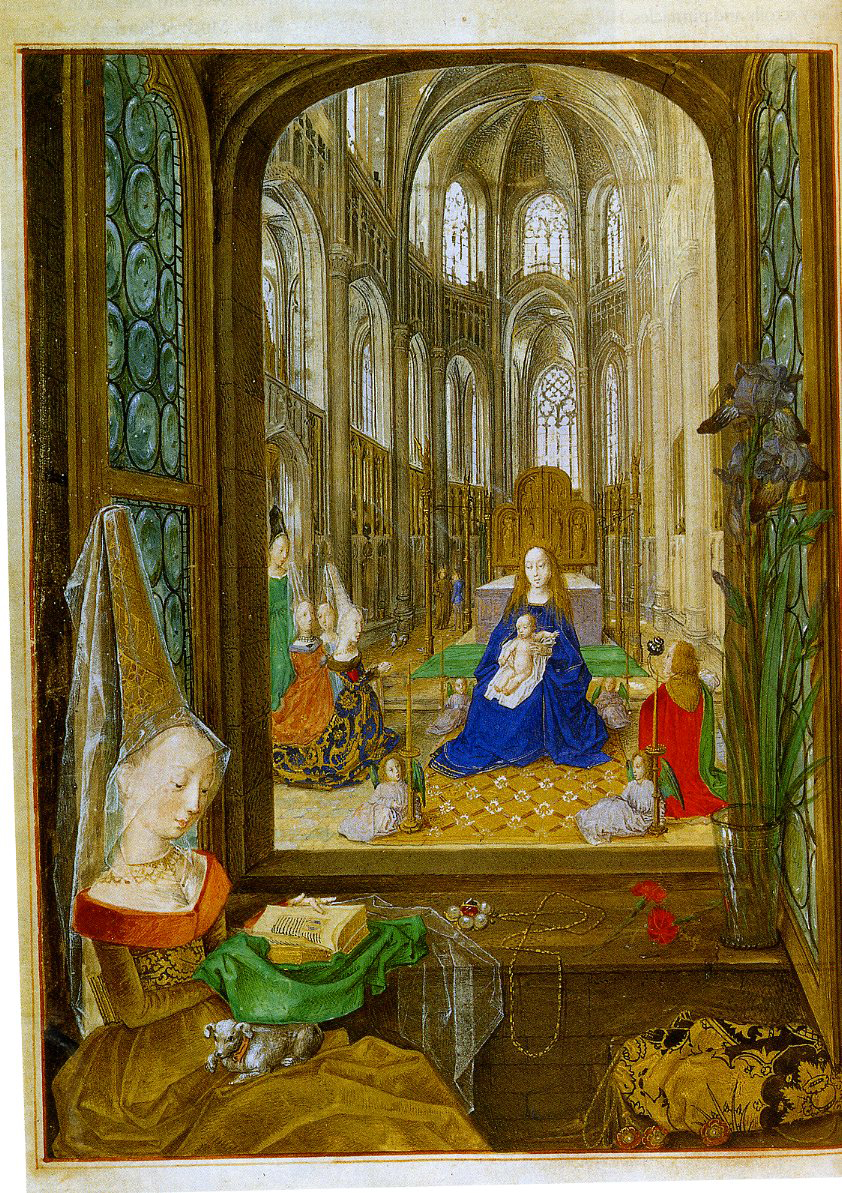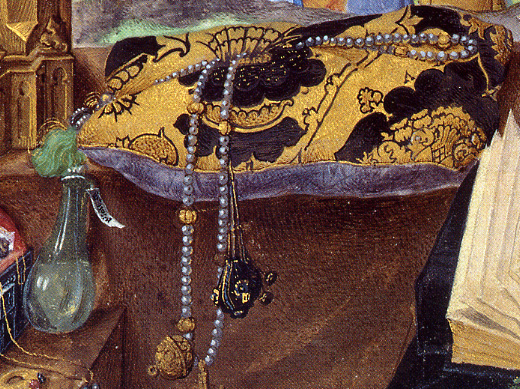The
“Black Hours,” refers to a Book of Hours that has been housed in the Pierpont
Morgan Library & Museum in New York as MS Pierpont Morgan
Library M.493 since the library purchased it in 1912. According to the Morgan Library, an anonymous
painter produced the manuscript in Bruges, Belgium in 1480. The Black Hours is
a small book, measuring only 170 mm x 122 mm (roughly 6 inches x 5 inches),
composed of 124 leaves of black-tinted vellum.
The Latin text of the Black Hours is written in silver and gold leaf in
single 17-line columns of textura script.
Its pages feature 15 chartreuse (light green/yellow) panels, with
initials and floral patterns drawn in yellow.
Fourteen full-page illustrations are drawn “in a restricted palette of
blue, old rose, and light flesh tones, with dashes of green, gray and white,”
(Pierpont Morgan Library) often featuring men and women in beautiful metallic
silhouettes. Nearly every other page is framed in a beautiful blue marginal
grounding and decorated with gold and silver vining, foliage, and grotesques. The
painter takes particular advantage of the black background, generously
highlighting and outlining figures in gold and silver.
In
a section of Masterpieces of Illumination
dedicated to the Black Hours, Walther and Wolf observe, “Manuscripts
completely immersed in black tint and written upon in gold and silver script …
can all be localized quite accurately, namely to the southern Low Countries,
today Belgium, and dated to the second half of the 15th
century.” (Walther et al., 372). The Black Hours’ origin in Burges places it
in a central city within the southern Low Countries that Walther et al. are
referring to. Over the course of the first half
of the fifteenth century, Burgundy emerged as an economic juggernaut, managing
booming wool and garment industries as well as operating as a cosmopolitan
market town that facilitated trade with a diverse array of European merchants,
from Portuguese spice traders to the Hanseatic Guilds of modern-day Northern
Germany, to the Genoese. When Philip III
(1396-1467) took up the post of the Duke of Burgundy in 1419, he resolved to
set up court in Burges. Philip’s court
consisted of an impressive circle of artists and craftsmen, and Philip himself
commissioned musical pieces, tapestries, jewelry, and the production of over
600 manuscripts, makng him the largest patron of manuscripts by volume in Europe
at the time. Philip’s heir, Charles the
Bold (1433-1477), continued his father’s tradition of book collecting, adding
hundreds of additional books to Philip’s collection. The Black Hours’ date of production sets it
squarely within the reign of Charles.
The
style of the Black Hours draws heavily from the techniques of one of Burgundy’s
most famous illuminators - Willem Vrelant.
A court favorite who set up his studio in Burges between 1454-1481,
Vrelant and his circle used specific techniques such as silver and gold lettering,
extreme drapery of clothing and illuminated highlighting, oblong, rectangular
framing, and black vellum staining, producing some of the most famous manuscripts
from this time. Some of these examples
include the Viennese Black Prayer Book and the Black Hours of Galeazzo Maria
Sforza. To produce these famous
blackened pages, Vrelant and his guild wuld dip the vellum for the manuscript
into an iron-copper solution. The
process was both expensive and time consuming, and the blackened parchment
would only hold lead white ink, gold ink, or silver ink on its pages.
Which brings us to a discussion of how the Black Hours reflects certain historical processes. For starters, the Black Hours was produced in Burges, Burgundy in one of the courts of its most powerful Duchies. The Black Hours’ was produced in the style of a renowned Flemish artist, William Vrelant, who was active at the Burgundian court and thus a trendsetter in artistic production. At a time when Burgundy functioned as the barometer of style for the rest of Europe in the realms of fashion, art, and high culture, manuscripts of such quality acted as both status symbol and movable capitol. Those who could afford as well-made a manuscript like the Black Hours commissioned them in an effort to distance themselves from the growing literate middle-class, which around the same period begun patronizing printing presses a la Johannes Gutenburg. As Walther et al. note, “In contrast to the mass appeal of stiff vestments covered with sumptuous gold and precious stones, how very cultivated must the noble, almost mystical black colouring have appeared!” (Walther et al., 372).







